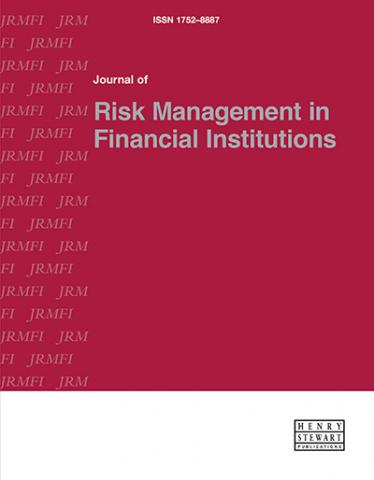“Journal of Digital and Social Media Marketing provides a unique blend of practitioner and academic expertise to offer the reader an in-depth understanding of digital marketing case studies and authoritative opinion. Each article passes a peer-review prior to publication, by leaders in the industry from around the globe, ensuring the reader gets the best-of-the-best in digital marketing insights.”
Press releases
18/10/2016 Press Release -- A revolutionary way to measure risk
The Journal of Risk Management in Financial Institutions (JRMFI), the leading peer reviewed journal on risk management, has published a two-part paper on a revolutionary method for measuring risk in its spring and summer editions. The fall issue will contain comments on this new method by six industry thought leaders.
The paper ‘Risk Accounting — The risk data aggregation and risk reporting (BCBS 239) foundation of enterprise risk management (ERM) and risk governance’ was published in the spring and summer 2016 editions of the Journal of Risk Management in Financial Institutions (JRMFI). In view of the significant interest shown by academics and practitioners during the peer review process, the Journal’s editors subsequently invited risk experts to comment on the published paper. These thought leaders were asked to opine on whether the novel concept of a ‘Risk Unit’ (a risk-sensitive measure) can be used to both express and aggregate all forms of risk.
In their paper, Allan Grody and Peter Hughes explain why financial institution executives, risk managers and accountants should seek to finance and risk systems within a common control and reporting framework. They document how Risk Accounting is designed as an ERM system to provide both a risk management and a risk control framework from which more effective programmes of risk governance and positive risk cultures can evolve. The authors describe how this might be achieved through a common risk measurement framework using the Risk Unit as the valuation metric. They argue that only through the adoption of such a framework can compliance with BCBS 239 risk data aggregation principles be achieved. The authors further describe how the risk quantification technique that underpins Risk Accounting represents a novel solution to the long-standing and still unresolved issue of how to explicitly and dynamically quantify exposures to operational risk. It is the hope of JRMFI’s editors that the expert contributors’ comments will further stimulate the debate on future directions for the next-generation of integrated finance and risk management methods and systems.
Excerpted comments:
"Risk Accounting – Part 1 and Part 2 – The risk data aggregation and risk reporting (BCBS 239) foundation of enterprise risk management (ERM) and risk governance by Allan Grody and Peter Hughes represents a sizeable step forward in the search for a practical global solution to enterprise risk management… I highly recommend the two volumes to readers."
"I applaud the authors’ thought leadership in proposing a common measurement framework for quantifying and aggregating risks within financial institutions. Their proposed framework is both novel in addressing the limitations of existing ERM risk measurement frameworks and practical in adapting the control and reporting frameworks that already exist in accounting and general ledger systems."
"The authors address a very important topic, which is the lack of comparability of risk information, and the need for standardised risk information akin to standard accounting and other financial metrics regularly published by banks and other financial firms. They make a compelling argument that risk comparability across different asset classes, risk types and ultimately across banks is possible using an approach that aggregates risk by assigning risk scores similar to the approach used in consumer Fair Isaac Corporation (FICO) scores."
"Having read through the papers I think the idea has some promise. Operational risk is a very opaque area and, with current modelling and reporting, it is virtually impossible to make any sort of quantitative sense out of either internal or external measures."
"I found both Risk Accounting papers to be well organised and that they laid out a solid framework for Risk Accounting and key concepts such as risk unit, exposure uncertainty factor, risk mitigation index, best practice scoring template, and a need for a solid taxonomy. The framework presented in Risk Accounting, Part 2, harmonises all quantifiable risks and valuation uncertainties into one consistent framework without getting bogged down with specific risk models, methodologies and calibrations. Ideally, if adopted, Risk Accounting would significantly improve comparability across companies, industries and cultures, and would provide further clarity for stock and credit analysts who must decide on relative valuations."
"I enjoyed reading Grody and Hughes’ Risk Accounting paper in the recent editions of the JRMFI. The integration of accounting and risk measures (both economic and regulatory) make an important contribution to making risk-adjusted returns transparent."
The Journal of Risk Management in Financial Institutions is a quarterly professional journal aimed directly at senior risk management professionals within the banking sector, companies providing a service to the financial sector, governments and academics throughout the world with an interest in financial risk management. The journal publishes briefings, discussion, applied research, case studies, comment and analysis on five inter-related areas of risk: strategic, financial, operational, regulatory and systemic. For more information on the journal, or to request a copy of the papers or the full comments on Risk Accounting please contact Julie Kerry (julie@hspublications.co.uk). For other enquiries, or to subscribe, contact:
North America:
HSP Subscriptions, PO Box 10812, Birmingham, AL 35202-0812, USA
Tel: 800-633-4931 • Fax: 205-995-1588 • Email: hsp@subscriptionoffice.com
Rest of World:
HSP Subscriptions, Russell House, 28/30 Little Russell Street, London, WC1A 2HN, UK
Tel: +44 (0) 20 7092 3465 • Fax: +44 (0) 20 7404 2081 • Email: gweny@henrystewart.co.uk


